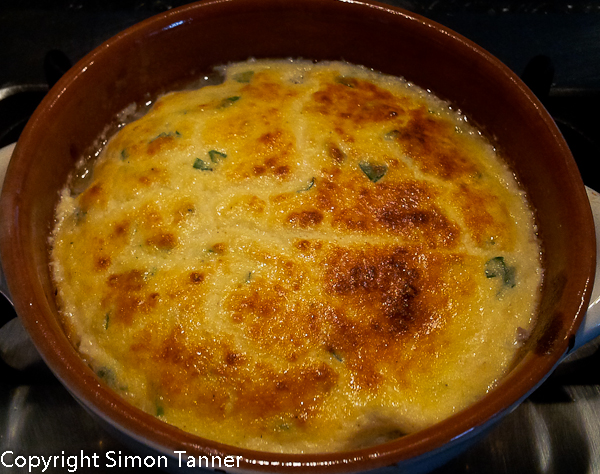Read this post in / Anche disponibile in: Italian
 Just for a change, we have a problem with names. My friend Caterina told me the dialect word sciusceddu comes from sciusciare (‘to blow’), in turn from the French souffler (courtesy of the Normans), deriving from the Latin subflare.
Just for a change, we have a problem with names. My friend Caterina told me the dialect word sciusceddu comes from sciusciare (‘to blow’), in turn from the French souffler (courtesy of the Normans), deriving from the Latin subflare.
She’s not alone in thinking this, but Giuseppe Coria, author of the iconic Profumi di Sicilia, the undisputed authority on Sicilian food, tells us that “there are various names for this dish, but the correct one is ciuceddu. It actually comes from the Latin juscellum, which means broth or soup. Despite the suggestive onomatopoeia, the word does not derive from the Sicilian dialect word sciusciare (to blow) …”
It’s also horribly difficult to pronounce properly. So difficult I won’t even try and explain. My friend Maria Grazia gave me a ten-minute lesson on how to get the initial ‘sc’ right, to no avail. Seeing as her premise was that only someone who had been born in Sicily had any hope of succeeding, she (and I) was clearly on to a loser from the outset, but it’s always fun to watch someone attempt the impossible.
It reminded me of when a Czech girl I once knew tried to teach me the exact pronunciation of the ‘ř’ in Dvořák. I had ended up wondering whether the teeth and lip movements required were possible without half a pint of slivovice inside you, or whether half a pint of slivovice is what you longed for after half an hour dribbling, pulling funny faces and making strange noises, much to the amusement of the Czech girl in question. Either way, I concluded that slivovice probably came into the equation at some point.
But, I hear you ask, who cares about what it’s called and how it’s pronounced? Who wants to know about my previous brushes with Czech girls? No, the important questions are: what is it, and do I want to eat it? The answers, respectively, are meatballs in broth with a ricotta soufflé top, and yes, most definitely. Well, these are my answers, but just for a change, opinion differs widely. It seems to be universally accepted that this is a traditional Easter dish from the Messina area, whose origins date back a good few centuries, but that’s where agreement ends. As to the exact ingredients, and as to whether it should have a final blast in the oven, there is no real consensus.
To be honest, there’s not even much of a consensus on whether it’s actually edible or not. This is a dish that divides public opinion in much the same way as, say, marmite. You either love it or you hate it. As far as I’m concerned, I have yet to try something containing ricotta that I don’t love, so I make no excuses for posting this. One version (many would say the original version, but frankly, my dear, I don’t give a damn) leaves out the final browning in the oven, but that for me is what raises it to the sublime. In fact, I even suspect that those who don’t like it have only tried the ‘original’ version. Let’s be honest, half-cooked scrambled eggs in broth is going to make baby food look attractive. But a golden crust atop a meltingly soft, airy ricotta soufflé? I rest my case.
Serves 4:
- 250g veal mince (although Giuseppe Coria suggests pork)
- 400g ricotta
- 700 ml stock (preferably chicken)
- 5 eggs
- a small bunch of parsley, chopped
- 3 tablespoons of grated pecorino cheese (or parmesan if you prefer a more delicate taste)
- 2-3 tablespoons of breadcrumbs
- sea salt, freshly ground black pepper
- Mix the mince with one of the eggs, a tablespoon of the grated cheese, a little of the parsley, a good pinch each of salt and pepper, and as many breadcrumbs as you need to obtain a fairly solid mixture (two or three tablespoons should do it). Make small meatballs about the size of a large cherry.
- Heat the oven to 190° C.
- Cook the meatballs in the boiling stock. They shouldn’t take more than 5-10 minutes.
- In the meantime, separate the eggs and reserve the whites.
- Mix the yolks with the ricotta, the remaining cheese, the remaining parsley and a good pinch of salt and pepper.
- Whisk the egg whites until stiff and then delicately add and fold in the ricotta mixture.
- Transfer the meatballs with a little stock into four ovenproof terracotta bowls and spoon over the egg and ricotta mix to cover the entire surface.
- Place the bowls in the hot oven for ten minutes, or until the top is golden brown, then serve immediately.
 English
English Italiano
Italiano
Most definitely better with veal than with pork. I make this dish regularly. Wash it down with a litre or two of vodka!